AP Macroeconomics Unit 1: Basic Economic Principles
1/39
Earn XP
Description and Tags
Name | Mastery | Learn | Test | Matching | Spaced |
|---|
No study sessions yet.
40 Terms
Scarcity
When the world has unlimited wants but we have limited resources. (one of the most important parts of economics)
Economics
The study of how individuals and societies allocate scarce resources to best satisfy unlimited wants and needs.
Macroeconomics
The study of a whole economy, aka country-level. (e.g, Economic growth, inflation, trade)
Positive statements vs. Normative statements
Positive statements are objective and fact-based, while normative statements are subjective and based on opinions or beliefs.
The 5 Key Economic Assumptions
People have unlimited wants and limited resources.
People make choices by weighing marginal costs and benefits.
People will do things in their self-interest (rational behavior).
All choices involve trade-offs.
Any real-life situation can be explained with simplified models and graphs.
Opportunity cost
The value of the next best alternative that is forgone when making a choice. This is a trade off. Such choices are made after marginal analysis.
The 4 Factors of Production
The 4 factors are:
Land - the natural resources used to produce goods and services (water, sunlight, animals)
Labor - the efforts people devote to a task and get paid for it (cashiers, doctors, servers)
Capital - there are two types of capital: physical (any human-made resources that creates other products, such as a tractor) and human (any skills or knowledge gained from education/experience)
Entrepreneurship - the risks people take that combine the other factors of production to create new products (Steve Jobs, Jeff Bezos)
The Production Possibilities Curve/Frontier
A model that shows how an economy will use its resources. It demonstrates scarcity, trade offs, opportunity costs, and efficiency.
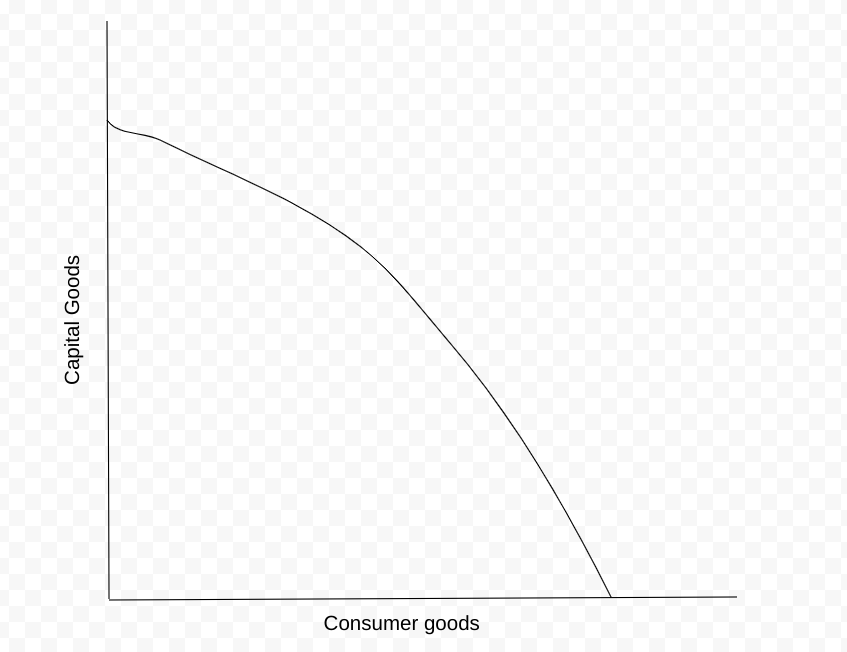
The 4 Assumptions of the PPC
Only two goods can be produced (capital and consumer).
All resources are fully used.
Resources are fixed (ceteris paribus)
Technology is fixed
Ceteris Paribus
A Latin phrase meaning “all things held constant”. It is commonly used by economists when describing situations.
On the PPC, when is the economy at…
Full employment/utilization: On the curve itself (A and B)
Little employment/inefficient: Inside the curve (C)
More-than-full employment/impossible: Outside the curve (D)
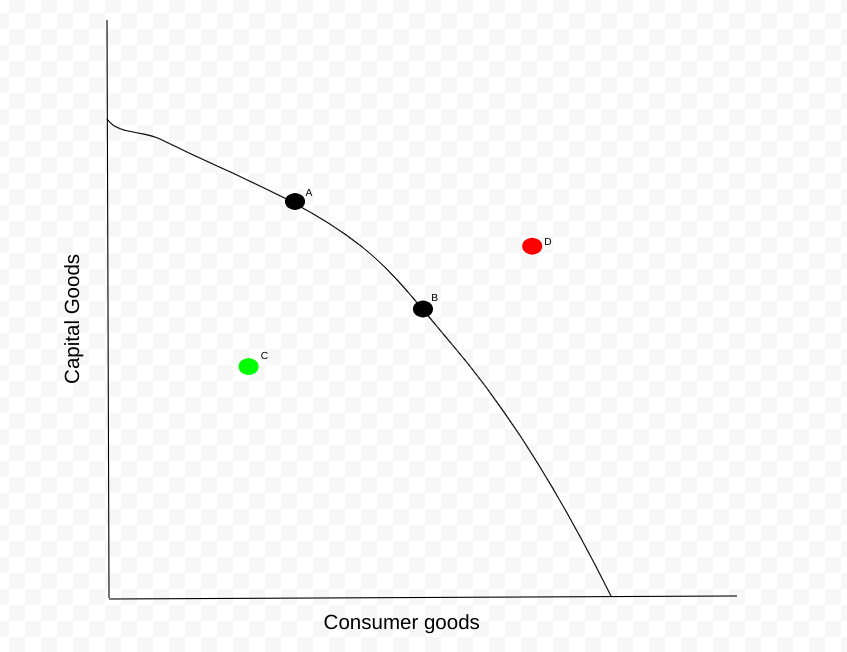
Different types of PPC curves
Constant: A straight line, the relationship is proportional
Increasing: A concave (bulging) curve, the opportunity cost increases with more of a product
Decreasing: A convex (caved-in) curve, the opportunity cost decreases with more of a product
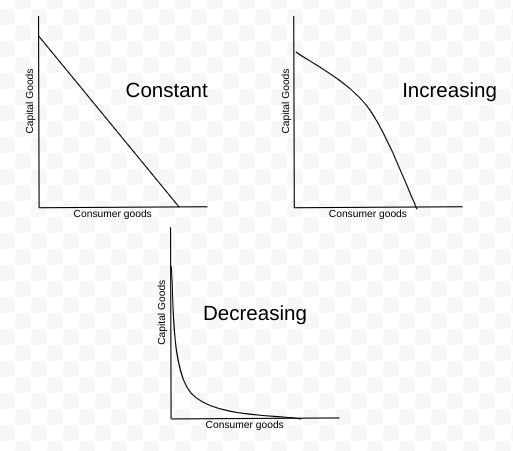
PPC shifters
Change in resource quantity/quality
Change in technology
Change in trade
When the PPC shifts out…
It’s a sign of economic growth!
More resources/quality increases
Better technology
More trade
One “axis” of the PPC may shift, it’s almost always the consumer product. (e.g, pizza when there are more pizza-making machines)
If a country focuses on capital goods, their economic growth will be more than those that focus on consumer goods.
When the PPC caves in…
It’s a sign of economic contraction
Less resources/quality decreases
Technology is destroyed
Less trade
Absolute vs Comparative advantage
Absolute advantage happens when a country can produce more of a product numerically.
Comparative advantage happens when a country can produce a good with the least opportunity cost.
Calculating per unit opportunity cost
Opportunity cost / Units gained
Output vs input questions
Output questions focus on the amount of things produced in a set period of time. (Other product goes over)
Input questions focus on the amount of time used to produce a product. (Other product goes under)
Terms of trade
The agreed-upon conditions of trade that benefit both countries.
Demand
The different quantities of goods that consumers will buy at different prices.
Price on y-axis, quantity demanded on x-axis
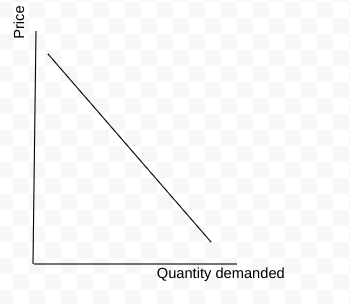
The Law of Demand
An inverse relationship between price and quantity demanded.
The Three Reasons Law of Demand Occurs are:
The substitution effect
The income effect
Law of Diminishing Marginial Utility
The Substitution Effect
If the price goes up for one product, consumers will generally shift their spending to a substitute product.
(e.g, Coke and Pepsi)
The Income Effect
When the price of a product goes down, or someone’s income goes up, then consumers will purchase more of that product (and vice versa).
Law of Diminishing Marginal Utility
As you consume anything, the satisfaction you receive will start to decrease after some time.
Determinants of Demand
Taste and Preferences
Number of consumers
Price of related goods (substitutes)
Income
Future expectations
Complement
Two goods that are usually used together. If the price of one product increases, usually both products will be bought more.
(e.g, dry-erase marker and whiteboard.
Normal vs. inferior goods
Normal goods: As income increases, so does demand. (e.g, luxury cars, houses)
Inferior goods: As income increases, demand decreases. (e.g, used books, instant noodles)
Change in Quantity Demanded vs Change in Demand
Quantity demanded refers to a position on the curve. The change is usually caused by price. Demand refers to the whole curve. The change is caused by the determinants of demand.
Supply
The different quantities of a good that sellers are wanting to sell at different prices.
Once again, price is the y-axis and quantity supplied is the x-axis.
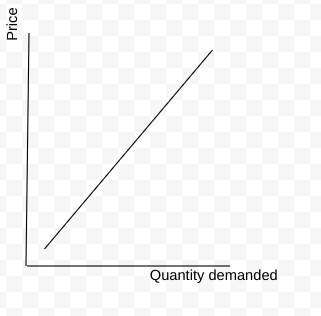
Law of Supply
There is a direct (positive) relationship between price and quantity supplied.
Determinants of Supply
Price/availability of inputs (includes workers)
Number of sellers
Technology
Government action (giving taxes and subsidies)
Expectations of future profit
Quantity supplied vs Supply
Quantity supplied refers to a position on the curve, and is often caused by change in price. Supply refers to the whole curve and is caused by the determinants of supply.
The supply and demand graph
Any point above the equilibrium is considered surplus.
Any point below the equilibrium is considered shortage.
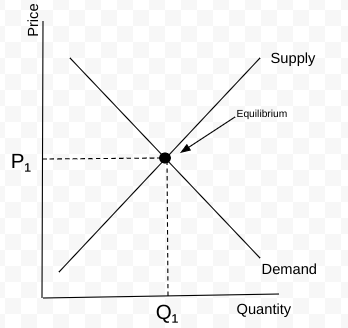
Shortage
When quantity demanded is greater than quantity supplied.
Surplus
When quantity demanded is less than quantity supplied.
Free Market System
The “invisible force” that pushes prices towards equilibrium.
Double shift rule
If two curves shirt at the same time, price or quantity will be indeterminate.
Price ceiling
The maximum legal price a seller can charge for a product to make it affordable for everyone. (black market ceiling is low)
Price floor
The minimum legal price a seller can sell a product.